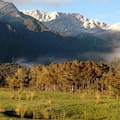Masterton was three days away from no longer being classified as “polluted” under national air quality standards.
But last Friday night, the readings of PM10 pollutants skyrocketed, breaching national standards for a second time this year.
The blip means Masterton will remain a “polluted airshed” for at least another five years under legislation.
The last time Masterton recorded a double breach of PM10 in one year was in July 2019, which locked the area in as a “polluted airshed” for five years.
The science behind the readings was not as straightforward as one would think.
A culmination of factors contributed to the breach, leading scientists have said.
Overnight last Friday, when PM10 readings were at their peak, the temperature in Masterton was a chilly -2.9C, according to MetService meteorologist John Law.
Added into the mix was high air pressure which creates a layer of air close to the ground trapping pollutants, Law said.
“Pollutants from fires, smoke, and chimneys all get trapped beneath this inversion layer.”
Dr Ian Longley, a scientist at NIWA, said the other factor which made Masterton prone to having air quality problems was its geography.
Being in the foothills, it is more sheltered from the wind.
“Wind is our friend and blows the smoke away,” he said.
Being in the foothills also meant the district was colder than coastal counterparts.
“So more people are putting more wood on the fire, which is generating smoke that is not blowing away as readily as it would elsewhere.
“Masterton is not unique in that sense but over the country as a whole it fits the pattern that it is not necessarily the largest cities that have the biggest air quality problems.
“You can’t remove the hills and you can’t change the wind.”
Changing habits this winter
What people could change was how they kept their homes warm in winter, a Masterton District Council spokesperson said.
The council said since monitoring began in 2011, the number of high pollution days per year had been reducing but that people needed to adopt better wood burning techniques “so that we’ve got clean air to breathe during winter”.
Tips include cleaning chimneys before each winter, making sure wood is dry and untreated, and not shutting the fire dampener (air vent) overnight.
People can check wood moisture levels using home health assessment kits which are available at the Masterton library.
PM10 are small airborne particles less than 10 micrometres across, about a fifth of the thickness of a human hair.
They are produced by the combustion of wood and fossil fuels, as well as by various industrial and natural processes.
These particles can easily be breathed in. When the largest particles are inhaled they get trapped in the nose and nasal passages and can cause irritation.
Smaller particles, called PM2.5, can enter lungs and also reach the bloodstream, resulting in respiratory diseases, heart attacks, and lung cancer.
So far this winter there have been 24 days where PM2.5 exceeded the World Health Organisation guidelines in Masterton.
Exceeding the guidelines was not covered by the National Environmental Standards for Air Quality [NES-AQ], but PM10 was.
One-strike rule
Only one breach per year was considered acceptable.
Any further breaches meant an area would be labelled a “polluted airshed” for five years.
Longley said many other countries had a tighter PM2.5 standard.
He said a proposal for new standards was “on the desk of the last Labour minister and got shelved with the election”.
“In many ways in terms of the legislative framework, everything is on hold,“ he said.
LDR is local body journalism co-funded by RNZ and NZ On Air.





















SHARE ME